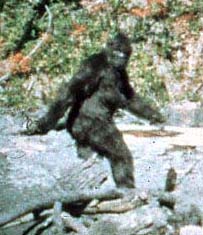
Probably just some teenage africans in a monkey suit having a little fun with the dumb college student researchers !
Posted on 04/15/2003 10:29:20 PM PDT by green team 1999
Elusive African Apes: Giant Chimps or New Species?
John Roach
for National Geographic News
April 14, 2003
A mysterious group of apes found in the war-torn Democratic Republic of Congo in central Africa has scientists and conservationist scratching their heads. The apes nest on the ground like gorillas but have a diet and features characteristic of chimpanzees. The apes are most likely a group of giant chimpanzees that display gorilla-like behavior. A far more remote possibility is that they represent a new subspecies of great ape. Researchers plan to return to the region later this month to collect more clues to help resolve the mystery.
The detective story began in 1908 when a Belgian army officer returned home with several gorilla skulls from near the town of Bili on the Uele River and gave them to the Belgium's Royal Museum for Central Africa in Tervuren. In 1927 the museum's curator classified the skulls as a new subspecies of gorilla, Gorilla gorilla uellensis.
Intrigued by the subspecies, Colin Groves, now an anthropologist at the Australian National University in Canberra, examined the skulls in 1970 and determined that they were indistinguishable from western gorillas, one of the two known species of gorilla. The case closed, and no further specimens of this gorilla from Bili have since been found.
But in 1996, Swiss-born, Kenya-based wildlife photographer and conservationist Karl Ammann re-opened the case and embarked on a quest to rediscover the mysterious gorillas.
To date, Ammann has not found the gorilla. But he has collected a wealth of information including skulls, ground nests, hair and fecal samples, footprints, and, most recently, photographs of what appears to be a chimpanzee that behaves like a gorilla.
Scientific analysis of this data is still being conducted. Ammann awaits the results before making an official announcement about the finds. Meanwhile, he continues to recruit scientists to study the case.
Shelly Williams, an independent primate behavior specialist in Atlanta, Georgia, who has a doctorate in experimental psychology, spent two months in the northern Democratic Republic of Congo last year trying to determine the identity of these apes. She said "at the very least, we have either a new culture of chimps that are unusually large or hybrids with unusual behaviors."
Williams and Groves will meet Ammann in Kenya this month before traveling to the Congo to conduct further studies on the mysterious apes.
Ground Nesting Chimp?
Since Ammann launched his quest, he has led expeditions into the Bili forest in the northern Democratic Republic of Congo where the original skulls were recovered. On his first trip, Ammann recovered a skull which had a pronounced ridge on its forehead characteristic of gorilla. The rest of the measurements link the skull to that of a chimpanzee.
For the next several years civil war in the Democratic Republic of Congo made travel to the Bili forest difficult. Ammann recruited a bush meat hunter from Cameroon to visit and survey the area. The hunter returned with photographs and reports of gorilla ground nests in an area north of Bili.
In 2000, Ammann returned to the area described by the bush meat hunter with a group of ape researchers. Although they did not find a live ape, the group did stumble across several well-worn ground nests in swampy river beds.
Ground nests are characteristic of gorillas. Chimpanzees are thought to prefer to sleep in trees. However, an analysis of feces found in the nests suggests that whatever left them was eating a diet rich in fruits, a diet characteristic of chimpanzees, not gorillas.
Other evidence collected from the site includes hair samples, which have been sent out to various laboratories for DNA analysis. The initial results indicate they belong to a chimpanzee. All of this evidence is causing the researchers to believe that what Ammann has found is a chimpanzee that behaves like a gorilla.
"It is a chimpanzee," said Esteban Sarmiento, a functional anatomist at the American Museum of Natural History in New York who traveled to the region with Ammann in 2000. "There are presently three recognized subspecies of common chimpanzee Pan troglodytes and it could represent a fourth subspecies or change our present understanding of where to draw the divisions between subspecies."
Giant Chimps
Local hunters in the region added to the mystery when they told Ammann and his colleagues about two kinds of chimpanzees in the region. Normal chimps, so-called "tree-beaters," are easily killed with poisonous arrows when they feed in trees.
Another, large chimpanzee seldom climbs trees and does not succumb to the poison arrows shot by the hunters. Called "lion killers," these big chimpanzees flee through the thick forest and disappear when shot at by hunters.
Evidence for these giant chimpanzees collected by Ammann includes a photograph of a cadaver alongside the hunter that killed it and casts of some large footprints. The pronounced ridge, called a sagittal crest, on the skull that Ammann found in 1996 is thought to be formed to support large jaw muscles, an indication of large body size.
"Giant chimpanzees occasionally occur here and there in the central and eastern subspecies, but evidence so far indicates that Karl [Ammann] may have a population of giants in his area," said Groves. "Presumably their giantism is relevant to their ground nesting behavior."
This group of what appear to be a distinct culture of ground-nesting chimpanzees is the now focus of Ammann's research. "Work has started on habituating one of the ground nesting chimp groups. This is done by provisioning them with sugar cane," he said.
This habituation will allow the researchers to document this new culture of chimpanzee as the researchers await the results of nuclear DNA analysis to determine if what they have is indeed a new subspecies of chimpanzee or simply a unique culture. Either way, the scientists are intrigued.
"Discovering an isolated group of apes exhibiting unusual cultural behaviors is just as important as identifying new DNA profiles. That's why continuous observation, habituation, and surveying are so important," said Williams.
Additionally, researchers have not yet given up on the possibility of finding gorillas in the area.
"I would think there is a strong possibility that south of Bili on the other side of the Uele River there may be gorillas, and this would seem an important area to turn our attention to," said Sarmiento.
for information and discusion only,not for profit etc,etc.

Probably just some teenage africans in a monkey suit having a little fun with the dumb college student researchers !
CONGO bump

LOL!
Wait...does Art Bell or George Noory know your feelings on this?

Disclaimer: Opinions posted on Free Republic are those of the individual posters and do not necessarily represent the opinion of Free Republic or its management. All materials posted herein are protected by copyright law and the exemption for fair use of copyrighted works.